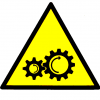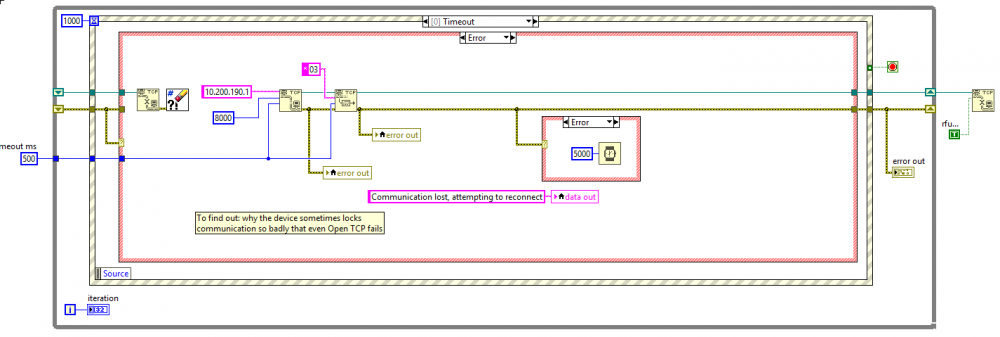-
Posts
583 -
Joined
-
Last visited
-
Days Won
26
Content Type
Profiles
Forums
Downloads
Gallery
Everything posted by ensegre
-

shifting the array element to different index
ensegre replied to qwerty3321's topic in LabVIEW General
- 1 reply
-
- 1
-

-
Isn't it the same I wrote about?
-
Firewall. Surely needs to be opened for the 5 relevant services on system 1, maybe on 2 too, I'm never sure; it is always so tedious to do. I wish someone had conocted a handy script for doing that automatically on every new LV installation.
-
From time to time, albeit sporadically, I have to build wrapper sets to .dll and .so, and I would love any improvement. Back in the days I was used to have to write my wrapper VIs one by one, and by now, especially for large libraries, the import wizard is a lifesaver to me. However, I end up still spending some amount of time, often significant, domesticating the .h files provided with the libraries so that the wizard sees better through them, writing LV translators between C structures and casted down byte arrays, creating ad hoc enum ring typedefs, hunting untranslated pointers, and similar chores. If that could be automated, I would enjoy it, though I agree that beyond some point that becomes project-specific. And at times (callbacks, message pumps i.e.) still no choice but having to write C containers. Have btw the import tool parsing capabilities got any better across versions? (I vaguely think yes but I don't have fair data for a comparison)
-
I'm not really sure about what is going on. I left the thread dangling because at the time I wrote I ultimately got away with a minimal size which was about right for my application, but there are certainly some limitations. This is the code I ended up using; and just checking it blindly today (linux, LV2017), I see that for the particular VI I try to resize, the minimal size is 50x20, otherwise Error 1 (the VI has all window decorations turned off). I haven't found a correlation between these numbers and what is shown on that FP (controls, menubars, title), maybe there is. I might try to investigate further someday.
-

Trying to play the video in Reverse
ensegre replied to Elancheran's topic in Machine Vision and Imaging
Shootballing. It may very well be that the codec used for that video is incremental, so that only certain differences from the preceding image are encoded in the next. That at least is one of the tenets of mpeg. If that is the case, I wouldn't be surprised that reconstructing what looks as an innocent predecessor requires in fact to read much more information from disk, and perhaps more computation, than a successor. If so, that seem a characteristics of the codec used rather than a limitation of LV. For reversibility, perhaps a different codec should be considered.- 3 replies
-
- imaq
- labview 2017
-
(and 1 more)
Tagged with:
-
No crash for me past the 2000th folder in 2017/32, 2017/64, 2018/64 on ubuntu18. 2018/64 btw is much faster in that than the preceding.
- 11 replies
-
- labview 2017
- labview 2017 sp1
-
(and 2 more)
Tagged with:
-
Yeah, this is what I would do too. I'm assuming the goal is to make sure that if the program aborts the file isn't corrupt, but you can do that with flush file. If you're taking data every second the continuous open/seek/write/close/open... is going to take a toll. I normally use the open once - {carry on ref - flush file} - close at the end pattern as a rule too, but there could be an argument for the crooked way: the file is not locked for write by the OS in between writes. You never know what an end user might pretend to want to do, like editing the file externally during the test.
-
smithd just wrote it all, I myself would do pretty much like he says.
-
ok, nothing weird. I would perhaps have written the VI somewhat differently, but I don't spot a problem either.
-
Anything weird could happen in the init case, for i~=1 of the inner while, by chance? You don't show us what's in the other cases of the innermost frame.
-

How to delete phantom controls from a TypeDef
ensegre replied to Roger Moss's topic in User Interface
Another thought - where is the black ear on the cluster icon? I mean, are you sure that this cluster on the BD is really the one you typedef'd? And if it is, and if I look at your FP image, which controls are flag_Z and flag_E? Are "Auto zero-enabled" and "same kind" captions instead of labels? -

How to delete phantom controls from a TypeDef
ensegre replied to Roger Moss's topic in User Interface
If you attach your .ctl, maybe someone could look into it. Anyway, have you tried to autosize to fit the cluster? My guess are that the extra controls are in there, just far out of your current border. Reorder controls in cluster might also give you some hint. Just open your typedef, create a new cluster (this will temporarily break the typedef), and drag into it the elements you want to keep. When you are done delete the original cluster and apply changes. That saves you from replacing every single instance of it in your codebase. -
Update just for the record - a number of phone calls to the representatives, "so explain me again what error do you get" "Did you read my email?? When do I get an updated firmware?" I got this new firmware, whose release note spells Fixed Problems -------------- - some improvements in Ethernet communication and the problem disappeared...
-
Is anyone aware of a limitation on what the smallest possible FP size is? On LV 2017, I am under the impression that this is 116x41 on one windows machine, and 1x1 on a linux. Known issue, WM, or deserves a CAR? The reason I'm asking: I'm fiddling with the cosmetics of an Xcontrol. I would have nothing against a larger transparent border, but when I webpublish the big FP using it, the large transparent border turns grey on the snap png. ETA:, ah, https://forums.ni.com/t5/LabVIEW/How-to-set-front-panel-size-to-be-same-as-one-led/td-p/1565524 ETA2: ok, tried the snippet of that thread and get either no reduction or eloquent "Error 1 occurred at Property Node (arg 1) - Command requires GPIB Controller to be Controller-In-Charge" for tighter sizes.
-
crosspost: https://forums.ni.com/t5/LabVIEW/Read-Holding-registers-of-Radix-x-72/td-p/3835439
-
An UI glitch, I realize. On the toolbar, the light bulbs icons are inverted. The left one turns highlighting on, the right one off. The tooltips are correct.
-
Maybe 8.5 not supported on a newer OS? I can only say I have LV17 running ok on an i7 7567U, Win 10 enterprise 2016 LTSB
-
I tried Mouse up, and discovered that it works only if you choose the last element and move the pointer out of the popup window but still at the edge of the bevel. Curious to know too.
-

acs motioncontroller ACS motioncontroller command “ExtendedSegmentedMotion”
ensegre replied to Mavs's topic in LabVIEW General
I don't use this device, but: you mean what, you got a DLL exposing those functions, and you have a problem when calling this Ch.extendedSegmentedMotion() from labview? If so, are you able to call successfully any other function? If that is the case it may be a simple mistake in interfacing with the CLFN - calling convention, wrong typing of the arguments, or the like. What did you try and what are the results? -
Note taken. For the moment though I took the path of calling Pfeiffer service. It would make more sense to me that their firmware is buggy, failing to release a disconnected port. After all this device acts as a telnet server, when it refuses incoming connections I would blame it rather than the client. Oh, and no, today I had occurrences when neither windows nor linux could connect, as well as ones where disconnecting and reconnecting the cable a few times didn't lose it. Either I'm missing something in this tests, or something is fishy.
-
[after some more inconclusive tests with another linux laptop back-to-back and intranet, and dumb wiresharking]. Maybe. I mean, you're not suggesting to disable Nagle (that would effect all other traffic from the host NIC, probably not good), just to get the handle from that VI. I'll have to educate myself, e.g. https://stackoverflow.com/questions/3757289/tcp-option-so-linger-zero-when-its-required. I wish I could defer it to a rainy day, unless hangups with that device become frequent. Oh, is this in the way?
-
Still shamelessly hijacking. So I'm polishing this VI, using basic tcp/ip, and observe the following. I have occasional network disconnections, and work around then attempting to reconnect, if tcp read gave error. I'm testing it on various PCs, with the device connected back-to-back or through some amount of intranet. Disconnections are easily simulated by pulling the ethernet cable and reattaching. Now my consistent observation is: one linux machine, reconnection seems to work robustly well. Three windows machines, quite often re-open TCP fails with Error 56. Not even restarting labview helps, only power cycling the instrument does. [I haven't yet had the chance of trying when both win and linux are on the same intranet]. Any idea why this is happening, is windows basic tcp different? Can I force some kind of port release harder than with tcp close?
-
yes, wireshark with plain telnet should be easy. I got the impression that I ended in a case of "device refuses to admit the connection broke, and refuses a new connection because outbuffer is full", whatever. If so, avoidable with programming by not asking too much at once. For the rest, I'm probably there, by now. Pfeiffer Maxigauge TPG 366, btw. Thx both for the feedback!
-
Thanks for confirming, Rolf. I also suspect that in addition to that is that ::socket is a windows only concept, or perhaps I don't have a sane VISA on my linux dev. I'm actually progressing with plain TCP. I'm only stumbling in my device sometimes hanging and refusing connections, this was what confused me at the beginning. A matter of programming so to avoid the condition which causes the lock, rather than abruptly power cycle the device. Anyway, now seemingly related to the particular device and not to the communication layer.







